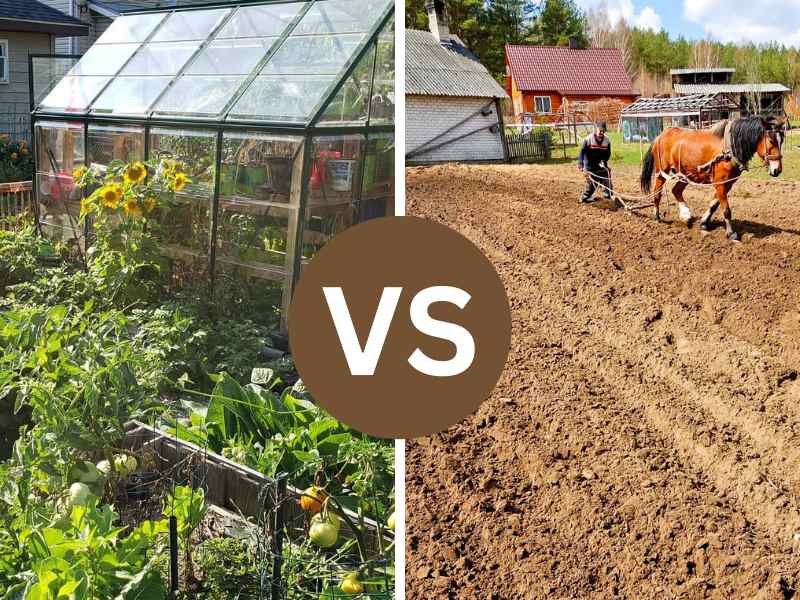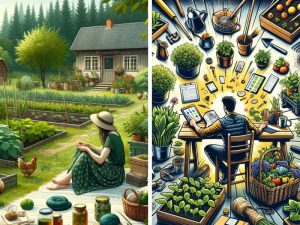Homesteading, the practice of self-sufficiency and living off the land, has experienced a resurgence in recent years. As people seek a simpler and more sustainable lifestyle, they often come across two terms: modern homesteading and traditional homesteading. While both approaches share a common goal of reducing reliance on external systems, they differ in various aspects.

In this article, we will explore the differences between modern homesteading and traditional homesteading, shedding light on their unique characteristics and benefits.
Defining Traditional Homesteading
Traditional homesteading traces its roots back to the 19th century when settlers ventured into new territories to establish self-sufficient farms. These pioneers relied on manual labor, basic tools, and limited technology to cultivate the land, raise livestock, and preserve food for sustenance. Traditional homesteaders often aimed to provide for their families and communities, emphasizing resilience and self-reliance.
The Emergence of Modern Homesteading
Modern homesteading, on the other hand, has emerged as a response to the challenges of contemporary living. While it shares the core principles of self-sufficiency with traditional homesteading, modern homesteading incorporates modern technologies, techniques, and resources to enhance efficiency and sustainability. It embraces innovation and leverages advancements in renewable energy, permaculture, aquaponics, and other practices to optimize the homesteading experience.
Scope of Land and Property
One key distinction between modern and traditional homesteading lies in the scope of land and property. Traditional homesteading typically involved staking a claim on a large tract of land, often dozens to hundreds of acres, allowing for extensive cultivation and livestock rearing.
In contrast, modern homesteaders may work with smaller plots of land, such as suburban backyards or even urban rooftop gardens. They creatively maximize available space, utilizing vertical gardening, container gardening, hydroponics, and aquaponics to grow their own food.
Use of Technology and Infrastructure
Technology plays a significant role in differentiating modern homesteading from its traditional counterpart. While traditional homesteaders relied solely on manual labor, modern homesteaders leverage various technological advancements to streamline their processes.
This may include using solar panels for energy production, water-efficient irrigation systems, and automated tools for gardening and livestock care. Additionally, modern homesteaders harness the power of the internet to access information, connect with a community, and market their products through online platforms.
Lifestyle Integration and Self-Sufficiency
Both modern and traditional homesteading embrace the idea of self-sufficiency, but their approaches differ in terms of lifestyle integration. Traditional homesteading often involves a complete break from mainstream society, with homesteaders living off the land in relative isolation.
Modern homesteading, on the other hand, encourages individuals to strike a balance between self-sufficiency and active participation in the modern world. Many modern homesteaders maintain jobs outside their homesteading endeavors, relying on their homesteads for supplementary income and a sustainable lifestyle.
- Hardcover Book
- John Seymour (Author)
- English (Publication Language)
Last update on 2024-07-26 / Affiliate links / Images from Amazon Product Advertising API
Focus on Sustainability and Permaculture
Sustainability and permaculture principles form a cornerstone of both modern and traditional homesteading. However, modern homesteaders often emphasize the integration of ecological design and regenerative practices into their homesteads. They strive to create closed-loop systems, reduce waste, conserve resources, and foster biodiversity. By utilizing concepts such as companion planting, rainwater harvesting, and natural pest control, modern homesteaders create resilient ecosystems that support long-term productivity.
Community and Collaboration
While traditional homesteading was often a solitary endeavor, modern homesteading places a strong emphasis on community and collaboration. Modern homesteaders recognize the value of connecting with like-minded individuals who share their passion for self-sufficiency and sustainable living. They actively seek out local homesteading communities, join online forums, attend workshops, and participate in farmers’ markets and swap meets.
By fostering a sense of community, modern homesteaders can exchange knowledge, resources, and support, creating a network of individuals who can learn from and inspire one another.
Economic Considerations
Economic factors also differentiate modern and traditional homesteading. Traditional homesteading was often driven by the need to provide for one’s family and generate income through the sale of surplus produce or livestock.
In contrast, modern homesteaders may approach homesteading as a means to reduce their reliance on external systems and become more self-sufficient while still maintaining other sources of income through employment or entrepreneurial ventures. Modern homesteaders may sell their excess produce, homemade goods, or value-added products through various channels, such as farmers’ markets, online platforms, or community-supported agriculture (CSA) programs.
Access to Information and Education
One of the significant advantages of modern homesteading is the ease of access to information and educational resources. With the proliferation of the internet and social media, modern homesteaders can tap into a vast wealth of knowledge, tutorials, and expert advice at their fingertips. They can learn about innovative techniques, troubleshoot challenges, and stay updated on the latest sustainable practices.
Traditional homesteaders, on the other hand, often relied on personal experience, passed-down wisdom, and a limited range of available resources to navigate the intricacies of self-sufficiency.
Mindset and Motivation
The mindset and motivation behind modern and traditional homesteading also differ to some extent. Traditional homesteaders were driven by the need to survive and establish a livelihood in harsh and challenging environments. They often faced isolation, hardship, and physical labor on a daily basis.
Modern homesteaders, while still valuing self-sufficiency, are often motivated by a desire for a more balanced, sustainable lifestyle that aligns with their values. They may prioritize environmental stewardship, mindfulness, and the pursuit of a simpler, more meaningful existence.
Conclusion
In summary, modern homesteading and traditional homesteading share the common goal of self-sufficiency and a desire to live in harmony with nature. However, modern homesteading incorporates technological advancements, embraces sustainability practices, encourages community engagement, and offers flexibility in terms of land size and integration with modern life. Traditional homesteading, on the other hand, relies on manual labor, larger tracts of land, and isolation from mainstream society.
Both approaches have their unique benefits and challenges, and individuals can choose the path that aligns best with their values, resources, and lifestyle preferences. Whether one embraces modern homesteading or traditional homesteading, the journey toward self-sufficiency is a fulfilling and rewarding endeavor that fosters a deeper connection with the land and a more sustainable way of living.




